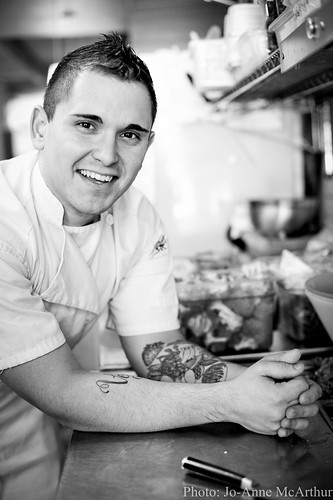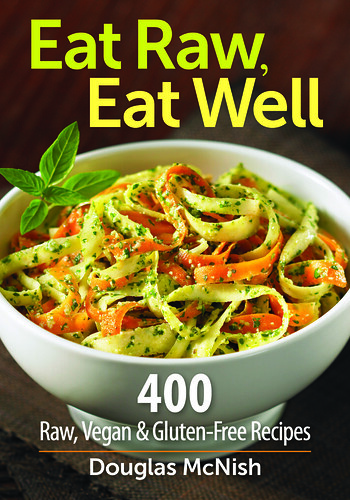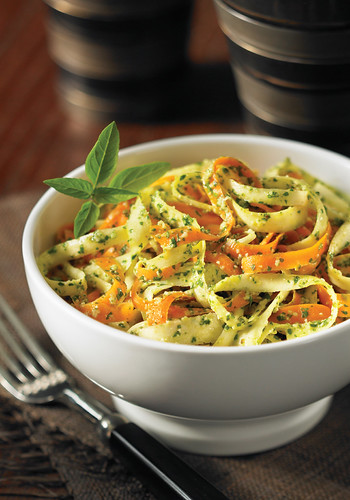
In a brave attempt to slim down after a summer that began and ended with magnificent wine and food festivals (Four Seasons Four Pinots and Kaanapali Fresh, I?m looking at you), I?ve picked up Toronto-based Douglas McNish?s new book Eat Raw Eat Well. Raw food recipes take the cook out of cookbook, but while your oven gets a break new gadgets like high-powered blenders and dehydrators come into play.
McNish clearly knows food?all food. He started out as a classically trained chef using products like meat and dairy, but later went vegan. At that point he began exploring other ways of preparing meals.
?At the age of 21, my weight hit an all time high of 270 or so pounds,? says McNish. ?I needed to make a difference in my life but did not know where to turn. It was around this time that I witnessed a video of animals in slaughterhouses and could not believe what I had witnessed. I made a conscious choice to phase out red meat and chicken for the first several months. After this time I went vegan. I stopped craving animal products. Plus, to me, it just made sense at that time. I?ve been vegan for over seven years now and feel great.?
For me, the transition is more complicated. I?m a dedicated animal lover, and as yet no gory slaughterhouse movies or images have made me stop craving burgers. My tastebuds win out over my mind every time.
But McNish?s book has turned me on to a whole new way of creating meals around vegetables and nuts. Besides, eating raw has a few delicious rewards. Because I have yet to purchase a dehydrator, I had to puree, chop, refrigerate or freeze my raw meals. It all sounds rather blah, I know, but raw foods have plenty of texture created with the use of a blade.
?The knowledge of not knowing where to start is one of the biggest barriers to jumping into a raw foods diet,? says McNish. ?I always say that changing one?s diet is like a relationship: you need to take the time to get to know it before jumping into it head first. I find that people often think that by switching over to a vegan diet, they will be missing something or feel deprived when it?s quite the opposite. There are so many foods out there that people never consume because they?re generally not found in the mainstream.?
One of the first things I noticed in McNish?s book is that preparing raw foods is not as instantaneous as you might think. It?s not just cutting up some veggies and throwing a handful of nuts into a bowl. Some ingredients require soaking time. If you want to make buckwheat porridge, that means soaking groats for a full 60 minutes. Almonds need to soak for at least an hour to make fresh almond milk.

Spicy Carrot Ginger Soup
Reading this, I definitely gravitated toward quicker preparations. Cashews require shorter soaking times, so making cashew milk and cashew cheeses went slightly faster. If making nut cheese sounds odd to you, you?re not alone. But where I lacked knowledge, this book served well and every recipe comes with a side bar of preparation tips that were really helpful.
The book is really great for beginners. It starts with chapters on how to transform and equip your kitchen. There?s also a chapter on ?raw food know how? that explains the theory behind eating a completely unprocessed diet.
The chapters list the 12 foods most contaminated by pesticides, and why you should buy organic. Other chapters are Breakfast, Smoothies and Drinks, Dips and Spreads, Soups, Salad Dressings, Sauces and Condiments, The Main Event, Sides and Small Plates, Snacks and Breads and Desserts. There is also a resource for buying raw ingredients and a list of websites that supply certified raw products.
?I like to look at this book as a bible of raw food recipes,? says McNish. ?I wrote it so it would be looked at as the type of book that contains any recipe you would want to be able to create on this diet. Whether you want to know how to make a cashew cheesecake, Cinnamon Toast Crunch smoothie, French onion flax cracker, Moroccan chickpea stew or Pad Thai sauce, it can be found in there. ?

Cashew Cheescake
Mmm? smoothies. I love making smoothies so I eased into McNish?s book with that chapter. Now my smoothie vocabulary includes a new and exotic terms like hemp milk, flax seed, cacao nibs and dried coconut. Making raw food smoothies means you can also throw away the protein powder because superfood smoothies are filled with great, fresh, raw ingredients that provide plenty of natural protein and vitamins without requiring a can of powder. The taste and texture of raw food smoothies are also rich and delicious. Flavors like apple pie and banana cream pie really taste like their namesakes, but don?t use any sugar or dairy products. The smoothie recipes alone make this a worthwhile purchase.
McNish?s book also has a surprising number of recipes designed to mimic familiar treats; the cashew spinach dip, for instance, is eerily reminiscent of the baked cheese-filled pub favorite. Many succeed in similar flavor and texture profiles. You can attribute this to McNish?s background in the food and beverage industry.
?I began cooking as a kid in high school at a British pub and instantly fell in love with every aspect of the professional kitchen,? he says. ?I went on to chef school and continued to hone my skills. After my two and a half year apprenticeship in a members-only club, I moved on and worked for some of the city?s busiest and best chefs. At 22, I made a conscious choice to ditch eating meat but continued to cook it for a living until I know what my next step would be. I made the choice to follow my passion and started to work at a vegan cafe. From there I took a job as head chef at a vegan restaurant and designed the entire menu. After my time there, I was the executive chef of a raw food restaurant for nearly two years. Since then, I?ve consulted for two high-end food service businesses, published my first cookbook (writing my second now) and am now self-employed. Looking back, I wouldn?t change a thing as I now know that I was supposed to be where I was at every point in my life.?

Another choice recipe included making noodles out of vegetables like zucchini by simply using a vegetable peeler and then topping them with a raw tomato marinara. The big lesson I learned from the soup chapter was that if you must eat your soup hot, go ahead and heat it, though it?s not considered raw.
I appreciated that McNish?s book was about flavor and not so much a dogmatic rendition of raw food philosophy. I will take many of these recipes into my repertoire, not because I?m vegan or raw food but because they?re great. The dessert section in particular has plenty of amazing confections, and I was surprised to learn how delicious pudding-like pies could be made without dairy. Knowing that, why bother go back to refined flour and sugar?
Unfortunately, I?ve not invested in a dehydrator and was unable to prepare about a third of the book?s recipes. But just reading them has intrigued me about dehydrated raw food items at the health food store.
They?re available at Choice Health Bar in Lahaina, Alive and Well in Kahului, Hawaiian Moons in Kihei and Mana Foods in Paia. Then when you?re ready to start spending on your own equipment, I hear that the best dehydrators come from Excalibur. McNish has recipes from pancakes and crepes to pizza crust and cookies in that category.
?You dehydrate foods by soaking, blending or processing, seasoning and then binding them back together again,? says McNish.?It really is quite a simple process. The most important things to understand are flavor combinations, how ingredients like flax or chia seeds work and how to utilize the right fats to create a pleasant mouth feel. Learn how flax seeds work to bind and bring together raw breads and crackers. Think big, bold flavors when thinking dehydrated foods?garlic, fresh herbs, tamari, etc.?
I had to twist McNish?s arm to get his top 10 essential ingredients for the raw food pantry. They include cashews, almonds, walnuts, dates, hemp seeds, nutritional yeast, wheat-free tamari, sunflower seeds, chia seeds and buckwheat groats. But that?s only if he had to chose just 10. There are so many more ingredients that he stocks as well.
?Coming to the realization that all beings (regardless of what type of living being they are) feel pain, love, hurt, anger or happiness was the driving force in helping to get me to be where I am today,? he says. ?Coming to the realization that I have the ability to make positive change in peoples lives on an ethical level and in their health through teaching them the skills necessary to help with clean recipe preparation is one of my most proud vegan accomplishments.?
Link Resource:
?
http://www.robertrose.ca/
www.DougMcNish.com
http://www.robertrose.ca/book/eat-raw-eat-well
http://dougmcnish.com/blog/
https://twitter.com/#!/RobertRoseBooks
https://twitter.com/DougMcNish
https://www.facebook.com/pages/Robert-Rose-Books/132036056831784
http://www.facebook.com/pages/Doug-McNish/120014678079072?ref=hl
***
Intrigued? Here are two recipes straight from McNish?s book that you can try at home:

Pesto Coated Carrot Parsnip Fettuccini
?
PESTO-COATED CARROT AND PARSNIP FETTUCCINI
This dish is a great way to get as many healthy ingredients into your body as possible without having to sacrifice any of the things you love. The softness of the root vegetables makes it reminiscent of traditional al dente pasta.
Makes 2 servings
3 large carrots, peeled 3
3 large parsnips, peeled 3
1 tbsp cold-pressed (extra virgin) olive oil 15 mL
1?4 cup freshly squeezed lemon juice, divided 60 mL
11?2 tbsp fine sea salt, divided 22 mL
3?4 cup cold-pressed hemp oil 175 mL
1?2 cup raw shelled hemp seeds 125 mL
3 cloves garlic 3
3 cups chopped fresh cilantro leaves 750 mL
1. Using a vegetable peeler, peel carrots and parsnips into long, thin strips, dropping into a bowl as completed (see Tips) Add olive oil, 1 tsp (5 mL) lemon juice and 1?4 tsp (1 mL) salt and toss until vegetables are well coated. Set aside for 10 minutes, until softened.
2. In a food processor fitted with the metal blade, process hemp oil and seeds, garlic and remaining lemon juice and salt, until somewhat smooth but the hemp seeds retain some texture. Add cilantro and process until chopped and blended, stopping the motor once to scrape down the sides of the work bowl. Add pesto to fettuccine, toss well and serve.
?
Tips
Peeling the vegetables lengthwise produces the long, thin strips required for this recipe. For best results use a Y-shaped (slingshot) vegetable peeler. When using a regular peeler, you can glide down the length of the vegetable to make one long, thin strip.
If you prefer, combine the ingredients for the marinade in a small bowl before tossing with the vegetables, to ensure even integration.
?
***
?
CASHEW CHEESECAKE
This rich cake is particularly delicious served with fresh berries and a sprinkle of cinnamon. I like to save this for special occasions. You will need a high-powered blender to achieve the smoothest consistency possible.
Makes 16 servings
? High-powered blender
? 9-inch (23 cm) springform pan
Filling
4 cups raw cashews, soaked (see Tips) 1 L
1 cup filtered water 250 mL
1 cup raw agave nectar 250 mL
1 cup melted coconut oil (see Tips, 250 mL? page 361)
1 tbsp raw vanilla extract 15 mL
2 tsp freshly squeezed lemon juice 10 mL
Crust
2 cups whole raw pecans 500 mL
1?4 cup chopped pitted soft dates 60 mL
1?2 tsp fine sea salt 2 mL
1. Filling: In a high-powered blender, combine soaked cashews, water, agave nectar, coconut oil, vanilla and lemon juice. Blend at high speed until smooth and creamy. Set aside.
2. Crust: In a food processor, pulse pecans, dates and salt until smooth (no large pieces should remain). Press into bottom of pan, ensuring that there are no gaps.
3. Assembly: Pour filling over crust and freeze for at least 2 hours or until firm in the center. This dessert can be made ahead and kept in the freezer for up to 1 month.
4. When you are ready to serve, remove from freezer and set aside to thaw for 15 to 20 minutes. Remove pan sides and slice. Serve immediately or cover and refrigerate for up to 1 week.
?
Tips
To soak the cashews for this recipe, cover with 8 cups (2 L) water. Set aside for 1 hour. Drain, discarding soaking water, and rinse under cold running water until the water runs clear.
To check if the cake is frozen all the way through, insert a tester such as a wooden skewer or toothpick. If it comes out clean, then the cake is ready to be thawed.
For decades, coconut products (coconut oil, milk and flesh) have been painted with the anti?saturated fat brush, based on the assumption that saturated fat increases the risk for cardiovascular disease. However, recent studies have found otherwise, so long as the coconut products are unprocessed. In fact, an impressive benefit of coconut products is their ability to boost HDL (?good cholesterol?), which helps to reduce the risk for cardiovascular disease. Coconut is high in a type of saturated fat called medium-chain triglycerides (MCTs), which are unique in the sense that they are burned for energy and are less likely to be stored as body fat.
?
checkers imbibe msg network ray j anthony shadid gary carter this means war
No comments:
Post a Comment
Note: Only a member of this blog may post a comment.